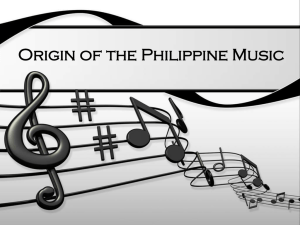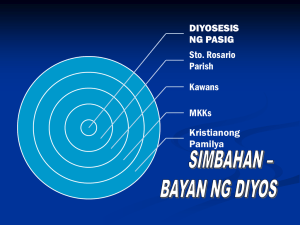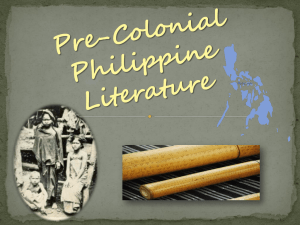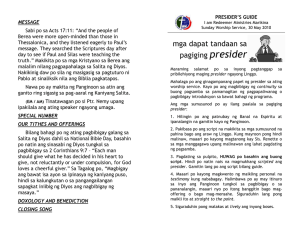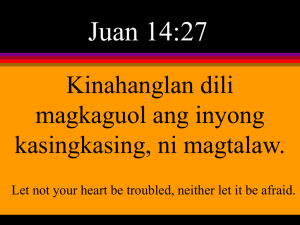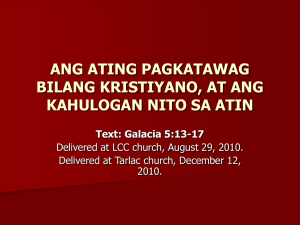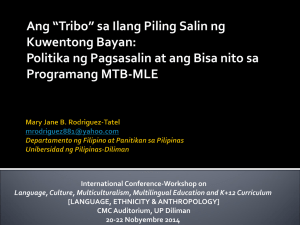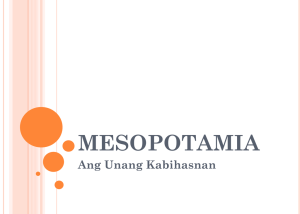Slide 1 - PNU
advertisement
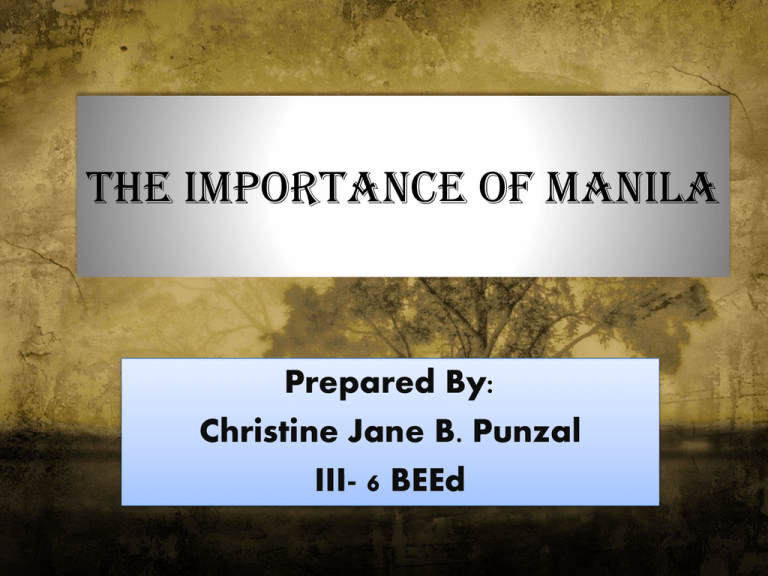
The Importance of Manila Prepared By: Christine Jane B. Punzal III- 6 BEEd Manila galleon Spanish sailing vessel that made an annual round trip (one vessel per year) across the Pacific between Manila, in the Philippines, and Acapulco, in present Mexico, during the period 1565– 1815. They were the sole means of communication between Spain and its Philippine colony and served as an economic lifeline for the Spaniards in Manila. During the heyday of the galleon trade, Manila became one of the world’s great ports, serving as a focus for trade between China and Europe. Though Chinese silk was by far the most important cargo, other exotic goods, such as perfumes, porcelain, cotton fabric (from India), and precious stones, were also transshipped via the galleon. On its return voyage, the vessel brought back huge quantities of Mexican silver and church personnel bearing communications from Spain. Negative result of galleon trade Positive result of galleon trade By 1687, a community of Christian Chinese and mestizos was already formally based in Binondo. Retail and small credit business came under the control of Chinese mestizos. Negative result The galleon trade had a negative effect on economic development in the Philippines. The neglect of native extractive industries like agriculture. Positive result The intercultural exchanges between the Philippines and the Americans, symbolized by no less than the Mexicanmade Virgin of Antipolo, chosen as the patroness of the sailors. The mango de Manila, tamarind and rice, the carabao (known by 1737 in Mexico), cockfighting, Chinese tea and textiles including the famous manton de Manila, the use of nipa palm raincoats (shirgo or chino), fireworks display, chinaware, and even tuba-making came to Mexico through the trans-Pacific trade. In exchange, the return voyage brought innumerable and valuable flora and fauna into the Philippines: avocado, guava, papaya, pineapple, horses and cattle. The moro-moro, moriones, and the image of the Black Nazarene of Quiapo, were also of Mexican origins. A considerable number of Nahuatl (aztec) elements crept into the Philippine languages, such as tiyangge (tianquiztli), kakaw (cacahuatl), tsokolate (xoco-atl), tamales (tamalli), kamatsili (quauhmochitl), sayote (chayotli), singkamas (xicama) and tocayo (tocaitl). The Mexicans, borrowed the Filipino words tuba (coconut toddy), hilanhilan (ilang-ilang), and parian. Lungsod ng Maynila Ang Maynila ay ang pangunahing lungsod at kabisera ng Pilipinas mula pa noong 1571 hangggang 1948 at mula noong 1976 hanggang sa kasalukuyan Sinakop ang Maynila ng mga mananakop na Espanyol noong 1571. Pinatunayan ng mga Espanyol ng batong bakod ang paligid ng pamayanan at tinatawag itong Intramuros o ilunsod na pinaligiran ng bakod na bato. Sa paglaki ng populasyon lumaki nang lumaki ang lungsod patungo sa iba-ibang direksyon na nagbigay –daan sa pagkatatag ng mga distrito sa Maynila. Ang mga daan sa lungsod ay naaayon sa kaayusan na kombinasyong radial at rectangular na balangkas. Ang mga kalakalang distrito ng Sta. Cruz at Quiapo ang mga puntong pokal (focal points) ng lahat ng mga linya ng transportasyon. Anim na tulay Roxas Jones MacArthur Quezon Ayala Mabini Ang Ilog Pasig ang ginawang reperensya sa hatian ng mga distrito, pito sa bawat panig ng Ilog Pasig. Hilaga na bahagi ng Maynila Tondo Timog na bahagi ng Maynila Port Area San Nicolas Intramuros Binondo Ermita Sta. Cruz Malate Quiapo Paco San Miguel Pandacan Sampaloc Sta. Ana Ang San Nicolas, Binondo, Sta. Cruz at Quiapo ang mga sentro ng komersyo at kalakalan. Pinakamalaki ang populasyon sa Tondo sa lahat ng mga distrito sa Maynila. Pinakamaliit pa ito sa Look ng Maynila. Ang San Miguel ay ang distrito na kinatatayuan ng Palasyo ng Malacanang, ang residensya na opisyal ng mga dating GobernadorHeneral at mga pangulo ng Pilipinas. Sa gawing silangan (east) ay ang distrito ng Sampaloc na sitio ng mga unibersidad at kolehiyo sa Maynila. Dito matatagpuan ang Unibersidad ng Sto. Tomas, ang unibersidad na matanda pa sa Harvard University sa Estados Unidos. Sa bahaging timog (south) naman na paharap sa look (bay) ay ang Port Area kung saan matatagpuan ang Custom House na namamahala sa paglilingkod ng pagbabarko (shipping services). Ang Intramuros (Walled City) ay ang matandang Maynila. Dito makikita ang Fort Santiago na naging guwardia sa pagpasok sa Ilog Pasig at forte na pinagbilangguan kay Dr. Jose Rizal. Sa timog (south) ng Port Area at Intramuros ay ang Rizal Park, ang pinakamagandang parke sa bansa. Ang Ermita at Malate ang kinatatayuan ng piling distritong residensyal na katatagpuan ng mga embassy at hotel. Sa looban ay ang mga lugar na komersyal na Paco, Pandacan at Sta. Ana . Bilang sentrong komersyal, pulitikal, edukasyonal, cultural at residensyal, bumilis ang migrasyon sa Maynila ng populasyon buhat sa mga lalawikan. populasyon ng Lungsod Maynila 93.75 (%)Pilipino 6.05 (%) Intsik 0.2 (%) ng ibang nasyonalidad Relihiyon ng Lungsod ng Maynila 93 (%) Romano Katoliko 2.1 (%), Protestante 2.0 (%), Buddist 1.4 (%), Iglesia ni Cristo 0.9 (%), Aglipay 2.6 (%) ang nabibilang sa ibang relihiyon. Thank you for listening!.

